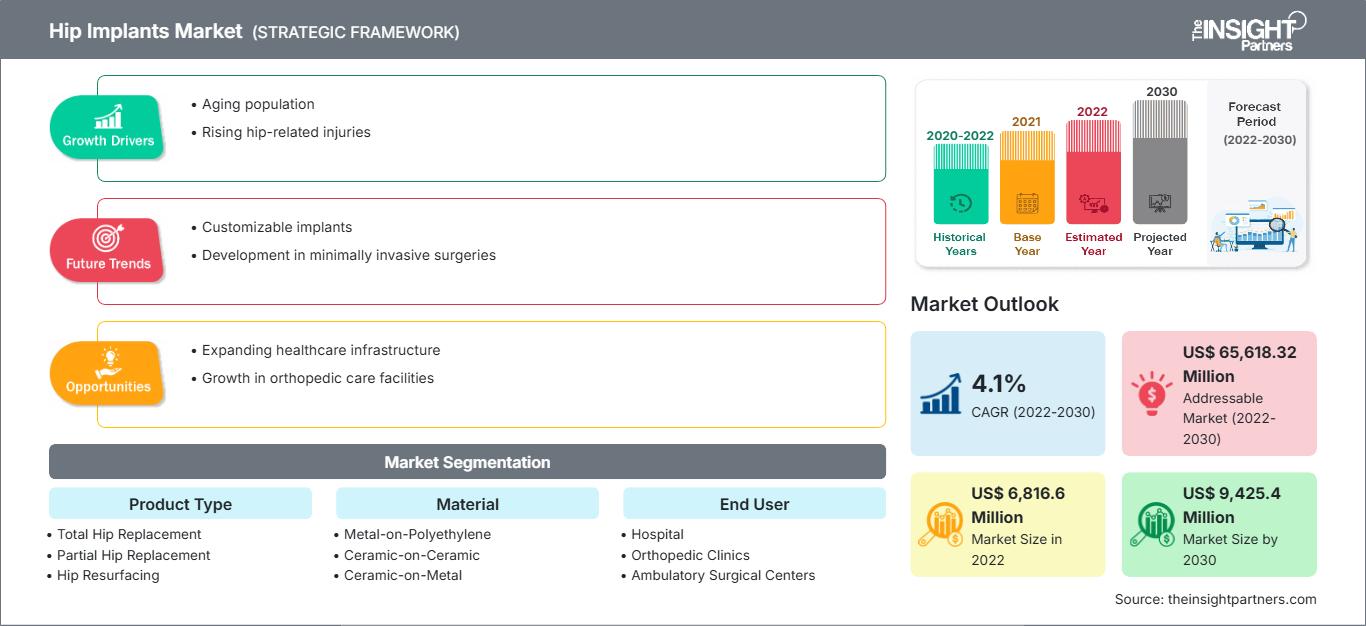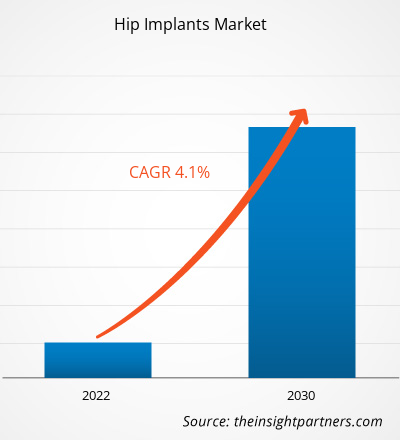[Forschungsbericht] Der Markt für Hüftimplantate soll von 6.816,6 Millionen US-Dollar im Jahr 2022 auf 9.425,4 Millionen US-Dollar im Jahr 2030 wachsen; von 2022 bis 2030 wird eine durchschnittliche jährliche Wachstumsrate (CAGR) von 4,1 % erwartet.
Markteinblicke und Analystenmeinung:
Der Markt für Hüftimplantate wächst aufgrund der Zunahme von Hüftoperationen, Hüftverletzungen, Osteoarthritis und rheumatoider Arthritis rasant. Darüber hinaus treiben strategische Initiativen von Unternehmen zur Erhaltung ihrer Wettbewerbsfähigkeit das Marktwachstum voran. So brachte Smith & Nephew im August 2023 das OR3O Dual Mobility System für die Erst- und Revisions-Hiparthroplastik in Indien auf den Markt. OR3O enthält aufgrund seiner Auskleidung und des proprietären OXINIUM auf XLPE die fortschrittliche Gleitfläche OXINIUM DH von Smith & Nephew. Dadurch werden sowohl die modulare CoCr-Auskleidung als auch die CoCr-Kopfkugel aus der Konstruktion entfernt, wodurch die mit der Legierung verbundenen Verschleiß- und Korrosionsrisiken verringert werden. Daher wird ein deutlicher Anstieg revolutionärer Technologien zur Erfüllung der Kundenbedürfnisse wahrscheinlich neue Trends in der Marktprognose für Hüftimplantate mit sich bringen.
Wachstumstreiber und Herausforderungen:
Laut der Osteoarthritis Action Alliance ist Osteoarthritis eine der häufigsten Formen von Arthritis in den USA und betrifft fast 32,5 Millionen Menschen, von denen 43 % der Bevölkerung im Jahr 2020 über 65 Jahre alt waren. Laut den Centers for Disease Control and Prevention litten im Jahr 2020 etwa 23 % der US-Bevölkerung an Arthritis. Laut Arthritis Research Canada leiden schätzungsweise über 6 Millionen Kanadier an Osteoarthritis, bis 2040 werden 10,5 Millionen prognostiziert. Osteoarthritis kann zu Hüftverletzungen und Hüftfrakturen führen, da die Knochendichte bei Arthritispatienten geringer ist als bei Nichtarthritispatienten.
Die Weltgesundheitsorganisation (WHO) schätzte die Bevölkerung über 60 Jahre im Jahr 2019 auf 1 Milliarde, was Die Zahl der über 60-Jährigen wird bis 2030 voraussichtlich 1,4 Milliarden und bis 2050 2,1 Milliarden erreichen. Der Anteil der geriatrischen Bevölkerung wird in diesem Zeitraum voraussichtlich von ca. 15 % auf ca. 24 % steigen. Einem anderen Bericht von Eurostat zufolge hatte Europa im Jahr 2021 den weltweit höchsten Anteil (20,8 %) an Menschen über 60 Jahren. Darüber hinaus werden bis 2050 in allen Regionen außer Afrika mehr als 25 % ihrer Bevölkerung die 60 Jahre überschritten haben. Der Anstieg der geriatrischen Bevölkerung hat somit die Prävalenz verschiedener orthopädischer Erkrankungen wie Hüftverletzungen, Osteoarthritis und Hüftverrenkung aufgrund von Stürzen und anderen unglücklichen Vorfällen erhöht, was zu einem Wachstum des Marktes für Hüftimplantate geführt hat.
Passen Sie diesen Bericht Ihren Anforderungen an
Sie erhalten kostenlos Anpassungen an jedem Bericht, einschließlich Teilen dieses Berichts oder einer Analyse auf Länderebene, eines Excel-Datenpakets sowie tolle Angebote und Rabatte für Start-ups und Universitäten.
Markt für Hüftimplantate: Strategische Einblicke

-
Holen Sie sich die wichtigsten Markttrends aus diesem Bericht.Dieses KOSTENLOSE Beispiel umfasst Datenanalysen, die von Markttrends bis hin zu Schätzungen und Prognosen reichen.
Berichtssegmentierung und -umfang:
Der Markt für Hüftimplantate ist nach Produkttyp, Material, Endverbraucher und Geografie unterteilt. Nach Produkttyp ist der Markt in Totalersatz, Teilersatz, Hüftgelenkserneuerung und Revisionshüftimplantate segmentiert. Nach Material ist der Markt in Metall-auf-Polyethylen, Keramik-auf-Keramik, Keramik-auf-Metall, Keramik-auf-Polyethylen und Sonstige segmentiert. Nach Endverbraucher ist der Markt in Krankenhäuser, orthopädische Kliniken, ambulante chirurgische Zentren und Sonstige segmentiert. Basierend auf der Geografie ist der Markt in Nordamerika (USA, Kanada und Mexiko), Europa (Großbritannien, Deutschland, Frankreich, Italien, Spanien, Russland und übriges Europa), Asien-Pazifik (China, Japan, Indien, Südkorea, Australien und übriger Asien-Pazifik-Raum), Naher Osten und Afrika (VAE, Saudi-Arabien, Südafrika und übriger Naher Osten und Afrika) und Süd- und Südamerika unterteilt. Mittelamerika (Brasilien, Argentinien und der Rest von Süd- und Mittelamerika).
Segmentanalyse:
Die Marktanalyse für Hüftimplantate ist nach Produkttyp in Femurrekonstruktion, Acetabulumrekonstruktion, Hüftoberflächenersatz, Revisionshüftimplantate, Lager- und poröse Metalltechnologien sowie Totalersatzimplantate unterteilt. Im Jahr 2022 hatte das Segment der Totalersatzimplantate den größten Marktanteil bei Hüftimplantaten und wird voraussichtlich zwischen 2022 und 2030 die höchste durchschnittliche jährliche Wachstumsrate (CAGR) verzeichnen.
Nach Material ist der Markt in Metall-auf-Polyethylen, Keramik-auf-Keramik, Keramik-auf-Metall und Keramik-auf-Polyethylen unterteilt. Im Jahr 2022 hatte das Segment Metall-auf-Kunststoff den größten Marktanteil bei Hüftimplantaten und wird voraussichtlich zwischen 2022 und 2030 die höchste CAGR im Markt für Hüftimplantate verzeichnen. Das Segmentwachstum wird durch Vorteile wie präzise Ergebnisse, Haltbarkeit und Kosteneffizienz vorangetrieben. Darüber hinaus treiben andere Vorteile wie weniger Komplikationen, technologische Fortschritte und weniger Verschleißpartikel die Nachfrage nach Hüftimplantaten auf Metall-auf-Kunststoff-Basis an.
Nach Endverbraucher ist der Markt in Krankenhäuser, orthopädische Kliniken, ambulante chirurgische Zentren und andere segmentiert. Im Jahr 2022 hatte das Krankenhaussegment den größten Marktanteil bei Hüftimplantaten und wird voraussichtlich zwischen 2022 und 2030 die höchste CAGR verzeichnen. Die steigende Zahl von Operationen für Hüftimplantate in Krankenhäusern treibt das Segment der Hüftimplantate weltweit voran. Außerdem ist das Krankenhauspersonal gut ausgebildet und sich der Komplikationen bewusst, die während oder nach Operationen auftreten können. Das Krankenhauspersonal ist darin geschult, Notfälle zu bewältigen und eine ausgewogene Patientenversorgung zu gewährleisten. Erstattungsverfahren für Operationen sind ebenfalls leicht verfügbar und können von der Krankenhausleitung verwaltet werden. Darüber hinaus wird die wachsende Zahl von Krankenhäusern weltweit wahrscheinlich die dominierende Stellung des Segments beibehalten und das Wachstum des Marktes für Hüftimplantate während des Prognosezeitraums fördern. Darüber hinaus wird die wachsende Zahl von Krankenhäusern weltweit wahrscheinlich die dominierende Stellung des Segments beibehalten.
Regionale Analyse:
Geographisch ist der Marktbericht für Hüftimplantate in Nordamerika, Europa, Asien-Pazifik, den Nahen Osten und Afrika sowie Süd- und Mittelamerika unterteilt. Nordamerika trägt am meisten zum Wachstum des globalen Marktes für Hüftimplantate bei. Der Asien-Pazifik-Raum wird voraussichtlich von 2022 bis 2030 die höchste durchschnittliche jährliche Wachstumsrate (CAGR) im Markt für Hüftimplantate aufweisen. Die zunehmende Zahl von Hüftimplantaten, Produkteinführungen und Hüftverletzungen beim Sport treiben hauptsächlich das Wachstum des Marktes in den USA voran. Laut dem Artikel „Hip Fracture Care and National Systems“ Laut einer von Wolters Kluwer Health, Inc. veröffentlichten Studie werden in den USA jährlich etwa 250.000–300.000 Menschen wegen Hüftfrakturen ins Krankenhaus eingeliefert. Schätzungen zufolge werden bis 2040 etwa 500.000 Menschen wegen Hüftfrakturen medizinisch versorgt werden. Laut der American Academy of Orthopaedic Surgeons sind in den USA Menschen ab 65 Jahren aufgrund von Stürzen im Haushalt oder in der Gemeinde anfällig für Hüftfrakturen. Laut dem in der National Library Medicine veröffentlichten Artikel „Hip Overview“ geben Patienten im ersten Jahr nach einer Hüftfraktur etwa 40.000 US-Dollar aus, und die Gesamtkosten für die Behandlung von Hüftfrakturen belaufen sich in den USA auf fast 17 Milliarden US-Dollar pro Jahr. Die zunehmende Häufigkeit von Hüftfrakturen und Hüftverletzungen in den USA und die steigenden Ausgaben für die Behandlung dieser Verletzungen sind somit ein aktueller Trend auf dem US-amerikanischen Markt für Hüftimplantate.
Hüftimplantate
Regionale Einblicke in den Markt für HüftimplantateDie Analysten von The Insight Partners haben die regionalen Trends und Faktoren, die den Markt für Hüftimplantate im Prognosezeitraum beeinflussen, ausführlich erläutert. In diesem Abschnitt werden auch die Marktsegmente und die geografische Lage in Nordamerika, Europa, dem asiatisch-pazifischen Raum, dem Nahen Osten und Afrika sowie Süd- und Mittelamerika erörtert.
Umfang des Marktberichts zu Hüftimplantaten
| Berichtsattribut | Einzelheiten |
|---|---|
| Marktgröße in 2022 | US$ 6,816.6 Million |
| Marktgröße nach 2030 | US$ 9,425.4 Million |
| Globale CAGR (2022 - 2030) | 4.1% |
| Historische Daten | 2020-2022 |
| Prognosezeitraum | 2022-2030 |
| Abgedeckte Segmente |
By Produkttyp
|
| Abgedeckte Regionen und Länder |
Nordamerika
|
| Marktführer und wichtige Unternehmensprofile |
|
Dichte der Marktteilnehmer für Hüftimplantate: Auswirkungen auf die Geschäftsdynamik verstehen
Der Markt für Hüftimplantate wächst rasant. Die steigende Nachfrage der Endverbraucher ist auf Faktoren wie veränderte Verbraucherpräferenzen, technologische Fortschritte und ein stärkeres Bewusstsein für die Produktvorteile zurückzuführen. Mit der steigenden Nachfrage erweitern Unternehmen ihr Angebot, entwickeln Innovationen, um den Bedürfnissen der Verbraucher gerecht zu werden, und nutzen neue Trends, was das Marktwachstum weiter ankurbelt.

- Holen Sie sich die Markt für Hüftimplantate Übersicht der wichtigsten Akteure
Branchenentwicklungen und Zukunftschancen:
Verschiedene Pläne der wichtigsten Akteure auf dem Markt für Hüftimplantate sind nachfolgend aufgeführt:
- Im August 2022 brachte Exatech ein neuartiges System für die totale Hüftendoprothese auf den Markt, bestehend aus Spartan Stem und Logical Cup. Der Spartan Hip Stem spiegelt die aktuellen Patientenbedürfnisse und die neuesten Fortschritte in der chirurgischen Behandlung wider. Der Logical Cup ist ein fortschrittliches, modulares Acetabulum-System, das den Anforderungen hochaktiver Patienten gerecht wird und gleichzeitig einen effizienten chirurgischen Ablauf in Krankenhäusern und ambulanten Operationszentren ermöglicht.
- Smith & Nephew brachte im September 2022 das OR3O Dual Mobility System für die primäre und Revisions-Hüftendoprothetik in Japan auf den Markt. Diese fortschrittliche Lageroberfläche, OXINIUM DH, wird für das lineare und proprietäre OXINIUM auf XLPE für seine Polyethyleneinsätze und den Femurkopf verwendet.
Wettbewerbslandschaft und wichtige Unternehmen:
Einige der im Marktbericht für Hüftimplantate behandelten führenden Akteure sind Smith & Nephew, Exactech, Zimmer Biomet, Stryker Corporation, DJO Surgical (Enovis), Medacta, Conformis, DePuy Orthopaedics, MicroPort Orthopedics und Symbios. Diese Unternehmen konzentrieren sich auf geografische Expansionen und die Einführung neuer Produkte, um der wachsenden Nachfrage von Verbrauchern weltweit gerecht zu werden und ihr Produktangebot in Spezialportfolios zu erweitern. Ihre globale Präsenz ermöglicht es ihnen, einen großen Kundenstamm zu bedienen und so die Marktexpansion zu erleichtern.
- Historische Analyse (2 Jahre), Basisjahr, Prognose (7 Jahre) mit CAGR
- PEST- und SWOT-Analyse
- Marktgröße Wert/Volumen – Global, Regional, Land
- Branchen- und Wettbewerbslandschaft
- Excel-Datensatz
Aktuelle Berichte
Verwandte Berichte
Erfahrungsberichte
Grund zum Kauf
- Fundierte Entscheidungsfindung
- Marktdynamik verstehen
- Wettbewerbsanalyse
- Kundeneinblicke
- Marktprognosen
- Risikominimierung
- Strategische Planung
- Investitionsbegründung
- Identifizierung neuer Märkte
- Verbesserung von Marketingstrategien
- Steigerung der Betriebseffizienz
- Anpassung an regulatorische Trends






















 Kostenlose Probe anfordern für - Markt für Hüftimplantate
Kostenlose Probe anfordern für - Markt für Hüftimplantate